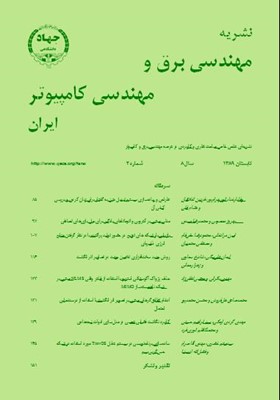بازيابي بار شبكههاي توزيع در حضور توليد پراكنده با در نظر گرفتن منابع انرژی ذخيرهای
محورهای موضوعی : مهندسی برق و کامپیوترامین مرادخانی 1 , محمودرضا حقیفام 2 , مصطفی محمدیان 3
1 - دانشگاه آزاد اسلامی واحد دهلران
2 - دانشگاه تربیت مدرس
3 - دانشگاه تربیت مدرس
کلید واژه: بازيابي بار شبكههاي توزيع توليد پراكنده جستجوي ممنوع,
چکیده مقاله :
امروزه تعداد و اندازه ژنراتورهاي DG متصل به سيستمهاي توزيع با سرعت در حال افزايش است. منبع DG در طي عمليات بازيابي ميتواند با ايجاد يک جزيره عمدي باعث سرعتبخشيدن به عمليات بازيابي شود. جزيره عمدي جهت بالابردن قابليت اطمينان بارهاي انتهايي شبکه که به شاخه پشتيبان ديگري دسترسي ندارند يک گزينه مناسب است و در غير اين صورت اين بارها در اثر ايجاد يک خطاي دائمي بايستي قطعي طولاني را تجربه کنند. اين مقاله روشي جهت بازيابي بار شبكههاي توزيع در حضور DG ارائه ميكند. روش ارائهشده، الگوريتمي مبتني بر جستجوي ممنوع با هدف كمينهكردن هزينه خاموشي مشتركين طي عمليات بازيابي بار است. در اين روش سعي شده كه با بازآرايي، ايجاد جزيره و در نهايت بارزدايي، بيشترين بار با بيشترين اهميت در كمترين زمان بازيابي شود. روش ارائهشده واحدهاي انرژيمحدود و محل تجهيزات سنكرونسازي در شبكه را در نظر ميگيرد. اين روش بر روي يك شبكه تست 32 باس اجرا شده و نتايج آن ارائه شده است.
DGs connected to distribution systems are increasing in size and number. Intentional islanding are proper alternatives to increase the reliability of end load in the network with does not access to any other branch. In other conditions these loads experiences permanent interruption. in load restoration operation, islanding is so important in the presence of DGs. Islanding is occurred when a part of distribution network is supplied only from DG sources. A new algorithm for distribution load restoration in the presence of DGs is presented in this thesis. the proposed approach minimizes the load interruption cost in restoration process based on Tabu search method. In this algorithm the maximum load with the most level of importance is restored in minimum time by reconfiguration, islanding and finally load shedding. Energy storage units and the location of synchronizing devices are considered in this thesis. The algorithm is implemented on a 32-bus test system and numerical results are presented.
[1] E. Carpaneto, G. Chicco, and A. Prunotto, "Reliability of reconfigurable distribution systems including distributed generation," in Proc. 9th Int. Conf. on Probabilistic Methods Applied to Power Systems, 6 pp., Stockholm, Sweden, 11-15 Jun. 2006.
[2] K. Aoki, K. Nara, M. Itoh, T. Satoh, and H. Kuwabara, "A new algorithm for service restoration in distribution systems," Paper 89 WM 085-2 PWRD, presented at the IEEE/PES 1989 Winter Meeting.
[3] A. L. Morelato and A. Monticelli, "Heuristic search approach to distribution system restoration," Paper 89 WM 1 11 -6 PWRD, presented at the IEEE/PES 1989 Winter Meeting.
[4] K. Aoki, T. Satoh, M. Itoh, H. Kuwabara, and M. Kanezashi, "Voltage drop constrained restoration of supply by switch operation in distribution systems," IEEE Trans. on Power Delivery, vol. 3, no. 3, pp. 1267-1274, Jul. 1988.
[5] I. Watanabe and M. Nodu, "A genetic algorithm for optimizing switching sequence of service restoration in distribution systems," in Proc. Congress on Evolutionary Computation, CEC2004, vol. 2, pp. 1683-1690, 19-23 Jun. 2004.
[6] Y. Fukuyama and H. D. Chiang, "A parallel genetic algorithm for service restoration in electric power distribution systems," in Proc. of the IEEE Int. 4th Conf. on Fuuzy Systems, vol. 1, pp. 275-282, 20-24 Mar 1995.
[7] S. Chavali, A. Pahwa, and S. Das, "A genetic algorithm approach for optimal distribution feeder restoration during cold load pickup," in Proc. Congress on Evolutionary Computation, CEC2002, vol. 2, pp. 1816-1819, 12-17 May 2002.
[8] Q. Zhou, D. Shirmohammadi, and W. E. Liu, "Distribution feeder reconfiguration for service restoration and load balancing," IEEE Trans. on Power System, vol. 12, no. 2, pp. 724-729, May 1997.
[9] D. Shirmohammadi, "Service restoration in distribution networks via network reconfiguration," IEEE Trans. on Power Delivery, vol. 7, no. 2, pp. 952-958, Apr. 1992.
[10] H. C. Kuo and Y. Y. Hsu, "Distribution system load estimation and service restoration using a fuzzy set approach," IEEE Trans. Power Delivery, vol. 8, no. 4, pp. 1950-1957, Oct. 1993.
[11] S. Toune, H. Fudo, T. Genji, Y. Fukuyama, and Y. Nakanishi, "A reactive Tabu Search for service restoration in electric power distribution systems," in Proc. of IEEE Int. Conf. on Evolutionary Computation (ICEC), pp. 763-768, 4-9 May 1998.
[12] Y. Y. Hsu and H. M. Huang, "Distribution system service restoration using the artificial neural network approach and pattern recognition method," in IEE Proc. of Generation, Transmission, and Distribution, vol. 142, no. 3, pp. 251-256, May 1995.
[13] J. H. Choi, J. C. Kim, and S. I. Moon, "Integration operation of dispersed generations to automated distribution networks for network reconfiguration," in Proc. IEEE Power Tech Conf., vol. 2, 5 pp., Bologna, Italy, 23-26 Jun. 2003.
[14] Distributed Generation as a Mean of Increase System Robuthness, CRISP , EESP Project ENK5-CT_2000
[15] F. Glover, "Tabu Search part I," ORSA J. of Computing, vol. 1, no. 3, pp. 190-206, Summer 1989.
[16] F. Glover, "Tabu Search part II," ORSA J. of Computing, vol. 2, no. 1, pp. 4-32, Winter 1990.
[17] C. S. Cheng and D. Shlrmohammadi, "A three-phase power flow method for real-time distribution system analysis," IEEE Trans. on Power Systems, vol. 10, no. 2, pp. 671-679, May 1995.


